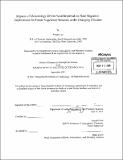| dc.contributor.advisor | Ronald Prinn. | en_US |
| dc.contributor.author | Lee, Eunjee | en_US |
| dc.contributor.other | Massachusetts Institute of Technology. Dept. of Earth, Atmospheric, and Planetary Sciences. | en_US |
| dc.date.accessioned | 2012-02-29T17:57:41Z | |
| dc.date.available | 2012-02-29T17:57:41Z | |
| dc.date.copyright | 2011 | en_US |
| dc.date.issued | 2011 | en_US |
| dc.identifier.uri | http://hdl.handle.net/1721.1/69469 | |
| dc.description | Thesis (Sc. D.)--Massachusetts Institute of Technology, Dept. of Earth, Atmospheric, and Planetary Sciences, 2011. | en_US |
| dc.description | Cataloged from PDF version of thesis. | en_US |
| dc.description | Includes bibliographical references (p. 164-169). | en_US |
| dc.description.abstract | As the impacts among land cover change, future climates and ecosystems are expected to be substantial (e.g., Feddema et al., 2005), there are growing needs for improving the capability of simulating the dynamics of vegetation structure across the global landscape as accurately as possible. In order to serve these needs, Dynamic Global Vegetation Models (DGVMs) are used to describe the current status of vegetation structure and biogeography as well as estimate their future dynamics, either with prescribed climates or coupled to climate models. Yet, current DGVMs generally assume ubiquitous availability of seeds and do not generally consider seed dispersal mechanisms and plant migration processes, which may influence the impacts of vegetation structural changes on the climate system (i.e., change in albedo, runoff, and terrestrial carbon sequestration capacity). For the first time, this study incorporates time-varying winddriven seed dispersion (i.e., the SEED configuration) as a dynamic constraint to the migration of natural vegetation in the Community Land Model (CLM)-DGVM. Compared to estimates of satellite-derived tree cover, simulations by this model configuration shows significantly improved representation of boreal forests in Western Siberia and temperate forests in Eastern Europe. The prevailing wind pattern, along with the existing vegetation structure in nearby grid cells, alters the competition dynamics of the trees in these regions by filtering unrealistic plant functional types through adjustment of establishment rates. The SEED configuration was applied to project future vegetation structures under two climate mitigation scenarios (No-policy vs. 450ppm CO 2 stabilization) for the 21st century. The simulation results indicate that regional changes of vegetation structure under changing climates are expected to be significant. In the high latitudes, regions such as Alaska and Siberia are expected to experience substantial shifts of forestry structure, characterized by expansion of needle-leaf boreal forest and shrinkage of C3 grass Arctic. In the mid-latitudes, temperate trees are likely to expand in South America, South Africa, and East Asia at the expense of C3 grass during the latter part of the 21' century. In the Tropics, the most notable degree of change is in the composition of tropical trees and C4 grasses in the Amazon and in Africa. | en_US |
| dc.description.abstract | (cont.) The vulnerability assessment suggested by this study shows that vegetation structures in Alaska, Greenland, Central America, southern part of South America, East Africa and East Asia are susceptible to changing climates, regardless of the two climate mitigation scenarios. Regions such as Greenland, Tibet, South Asia and Northern Australia, however, may substantially alleviate their risks of rapid change in vegetation structure, given a robust greenhouse gas stabilization target. The impacts of future vegetation change on radiation budget cannot be neglected. The results of this study suggest that depending upon the climate mitigation scenarios, vegetation change may enhance or mitigate the anticipated warming trend of the 21St century. Proliferation of boreal forests in the high latitudes to amplify the warming trend (i.e., a positive feedback to climate) if no mitigation policy is implemented. In contrast, under the 450ppm scenario, changes in vegetation structure may reduce the rate of warming, which is a negative feedback to climate. A series of hydrologic processes including interception of rainfall by forest canopy, evapotranspiration, and runoff are also influenced by modifications in vegetation structure. The magnitude of the runoff response by the vegetation change is not projected to exceed the direct response of hydrology to climate change (i.e., changes in precipitation); however, the spatial pattern of changes in runoff associated with vegetation changes indicates that vegetation change may in some regions offset or lessen increases in runoff due to enhanced precipitation under climate warming. Reduction of terrestrial productivity and a conservative estimate of vegetation carbon storage (-8PgC/yr and 24PgC, respectively under the no policy scenario) in the 21st century may be due to ignoring the CO₂ fertilization effect and partially applying the new SEED configuration to project future vegetation structures. The SEED configuration developed in this study may serve to more comprehensively represent future vegetation structure across the global landscape and therefore may provide a tool to better assess the impacts of natural vegetation dynamics on the climate system. This model configuration may also provide outputs that can be used to assess the impacts of climate change on the goods and services that ecosystems provide to society. | en_US |
| dc.description.statementofresponsibility | by Eunjee Lee. | en_US |
| dc.format.extent | 217 p. | en_US |
| dc.language.iso | eng | en_US |
| dc.publisher | Massachusetts Institute of Technology | en_US |
| dc.rights | M.I.T. theses are protected by
copyright. They may be viewed from this source for any purpose, but
reproduction or distribution in any format is prohibited without written
permission. See provided URL for inquiries about permission. | en_US |
| dc.rights.uri | http://dspace.mit.edu/handle/1721.1/7582 | en_US |
| dc.subject | Earth, Atmospheric, and Planetary Sciences. | en_US |
| dc.title | Impacts of meteorology-driven seed dispersal on plant migration : implications for future vegetation structure under changing climates | en_US |
| dc.type | Thesis | en_US |
| dc.description.degree | Sc.D. | en_US |
| dc.contributor.department | Massachusetts Institute of Technology. Department of Earth, Atmospheric, and Planetary Sciences | |
| dc.identifier.oclc | 775359690 | en_US |
